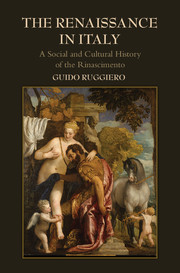Book contents
- Frontmatter
- Dedication
- Contents
- List of Illustrations
- Acknowledgments
- Maps
- Introduction: The End of the World and Its Rebirth (Rinascita) as the Rinascimento
- 1 Legitimacy: A Crisis and a Promise (c. 1250–c. 1340)
- 2 Civiltà: Living and Thinking the City (c. 1300–c. 1375)
- 3 Plague: Death, Disaster, and the Rinascita of Civiltà (c. 1325–c. 1425)
- 4 Violence: Social Conflict and the Italian Hundred Years’ War (c. 1350–1454)
- 5 Imagination: The Shared Primary Culture of the Early Rinascimento (c. 1350–c. 1475)
- 6 Courts: Princes, Aristocrats, and Quiet Glory (c. 1425–c. 1500)
- 7 Self: The Individual as a Work of Art (c. 1425–c. 1525)
- 8 Discovery: Finding the Old in the New (c. 1450–c. 1560)
- 9 Re-Dreams: Virtù, Saving the Rinascimento, and the Satyr in the Garden (c. 1500–c. 1560)
- 10 Reform: Spiritual Enthusiasms, Discipline, and a Church Militant (c. 1500–c. 1575)
- 11 Retreat: The Great Social Divide and the End of the Rinascimento (c. 1525–c. 1575)
- Epilogue: The Diaspora of the Rinascimento
- Bibliography: A Short List of Works Used
- Index
7 - Self: The Individual as a Work of Art (c. 1425–c. 1525)
Published online by Cambridge University Press: 05 December 2014
- Frontmatter
- Dedication
- Contents
- List of Illustrations
- Acknowledgments
- Maps
- Introduction: The End of the World and Its Rebirth (Rinascita) as the Rinascimento
- 1 Legitimacy: A Crisis and a Promise (c. 1250–c. 1340)
- 2 Civiltà: Living and Thinking the City (c. 1300–c. 1375)
- 3 Plague: Death, Disaster, and the Rinascita of Civiltà (c. 1325–c. 1425)
- 4 Violence: Social Conflict and the Italian Hundred Years’ War (c. 1350–1454)
- 5 Imagination: The Shared Primary Culture of the Early Rinascimento (c. 1350–c. 1475)
- 6 Courts: Princes, Aristocrats, and Quiet Glory (c. 1425–c. 1500)
- 7 Self: The Individual as a Work of Art (c. 1425–c. 1525)
- 8 Discovery: Finding the Old in the New (c. 1450–c. 1560)
- 9 Re-Dreams: Virtù, Saving the Rinascimento, and the Satyr in the Garden (c. 1500–c. 1560)
- 10 Reform: Spiritual Enthusiasms, Discipline, and a Church Militant (c. 1500–c. 1575)
- 11 Retreat: The Great Social Divide and the End of the Rinascimento (c. 1525–c. 1575)
- Epilogue: The Diaspora of the Rinascimento
- Bibliography: A Short List of Works Used
- Index
Summary
Reversing Burckhardt
Two of the most important elements of the paradigm that Jacob Burckhardt envisioned as distinguishing the Italian Renaissance were its discovery of the individual and its creation of the state as a work of art. More than a century of scholarship has largely demolished both evocative claims. Yet they were and are so pregnant with implications that they are often evoked today, perhaps because they seem to make the period so central to what many see as the very foundations of modern society and the modern sense of self and state. In many ways, however, one might argue that these claims actually work quite well in light of recent scholarship, if we merely reverse them: for it might well be argued that the Rinascimento discovered what we think of as the state and created the individual as a work of art.
Even if claims of discovery always seem to prove dangerous, still, as we have seen repeatedly from diverse perspectives, political power was reconceptualized during the period, becoming, if not quite public, at least envisioned in terms of an ideology that saw it as based on a shared civiltà: a type of urban civic morality melding communal and Christian values and serving a more general shared common good. Even signori felt it necessary at least to nod at such shared values, and many, including Machiavelli, wrestled with the problems created by such an ideology. In turn, especially in the aristocratic world of the fifteenth and sixteenth centuries, as far down the social scale as such pretensions existed (and perhaps farther), the individual became a more and more carefully considered and significant cultural construct, in many ways a work of art, painted socially in a series of complex negotiations that turned around consensus realities and the various groups with which an individual lived and interacted. The key here is “negotiations,” for in the negotiations that people wittingly or unwittingly carried out with the groups that surrounded them in society, self-fashioning became a more nuanced and complex ongoing social process. And it thus fit more comfortably at the very heart of premodern social life and individuality, making both less modern and more Rinascimento.
- Type
- Chapter
- Information
- The Renaissance in ItalyA Social and Cultural History of the Rinascimento, pp. 326 - 386Publisher: Cambridge University PressPrint publication year: 2014



